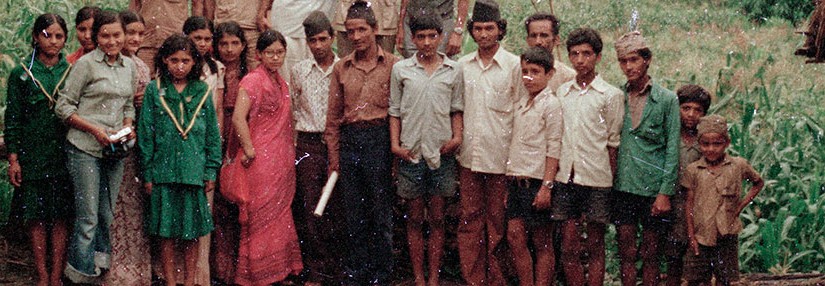History is made everyday, by people like you and me, through our daily actions, decisions and interactions. The history we learn in our schools, however, do not consider regular people as makers of history, but as mere spectators. Photo Kathmandu’s week-long celebration of the visual documentation of people’s stories seeks to break just that line of thought.
One of the 18 exhibitions showing at Photo Kathmandu is Sumitra Manandhar Gurung’s collection of photos. Titled ‘Time Maps and Memories,’ Sumitra’s photos convey a near-perfect blend of photography, history and socio-anthropology of Nepal in the 70s and 80s.
The word that came most often to my mind while viewing the photos was contrast – contrast between the modern and traditional, the young and old, the global and the local. Yet, the feeling that I left with is not that of a separation between the two objects being contrasted, but rather, the interconnection between them.
Sumitra Manandhar Gurung was born in Ason in 1954 to a traditional Newar family. Sumitra’s grandfather owned the first bicycle store in Kathmandu and her father was a patron supporting the Buddhist Ananda Kuti Bihar. At a time when very few believed in educating girls, her family was adamant about educating everyone. And so, her aunts became the first batch to attend the first co-educational school in Kathmandu. Along with her siblings, Sumitra was educated at a time when girls were married off when they hit puberty. She ended up being one of the first women geographers of Nepal and travelled far and wide throughout the country for her Master’s degree — both unheard of for women in Nepal at that time.
Sumitra was lucky. Foreign visitors to the Ananda Kuti gave her uncle a camera and other photographic equipment as gifts. Her family used the camera to take photos of Buddhist events and of each other during their family picnics or riding bicycles through Kathmandu. The photos they took can now be viewed through a socio-historical lens, for the clothes that these people wore, the landscape of Kathmandu and the kind of Buddhism practiced during those days. Sumitra carried a camera with her and documented her journey through Nepal. The photos she took are not those of a picturesque, pastoral Nepal but ones that showcase Nepali society as it was.
Viewing the images through the eyes of a female photographer, who also happens to be a feminist, one particular photograph sticks out to me personally. It is one of Sumitra dressed in her signature bell-bottom pants, a shirt and a beret-like hat, looking through a geodolite as a group of men stand around her. When I first saw the image, I thought she was looking through a camera lens. I was surprised. For me, the image of a woman behind a camera has always signified power and this image was no different. Women like Sumitra have been breaking gender stereotypes since long before I was born.
As I viewed more photos, I started seeing not only the local and the very personal but also the global of that time. Her marriage to Chandra Gurung in Thailand, where they were both students, her time in the slums of Manila, where she once again strikes a contrast by wearing a sari, the seminars she attended, the places she visited, and her friends and family all point to a distinctly global consciousness. In the 70s and 80s, Sumitra was already photographing disaster-prone areas in Nepal. She photographed houses, villages, child brides as they were getting married and young girls smoking cigarettes.
Time flows through Sumitra’s collection of photos; it does not remain stagnant and stuck in one memory. Sumitra’s photos are her observations of the world around her and the ones taken by others are an observation of Sumitra in her world. She was not only recording history, but also making it.
Going through Sumitra’s photos was a historical journey for me. It felt like I was watching a woman who broke barriers so that women like myself could follow down the road she had paved. Sumitra’s life and journeys are reflected seamlessly in the exhibition. Like her grandfather’s bicycles, they keep moving on.
Text by Pooja Pant

